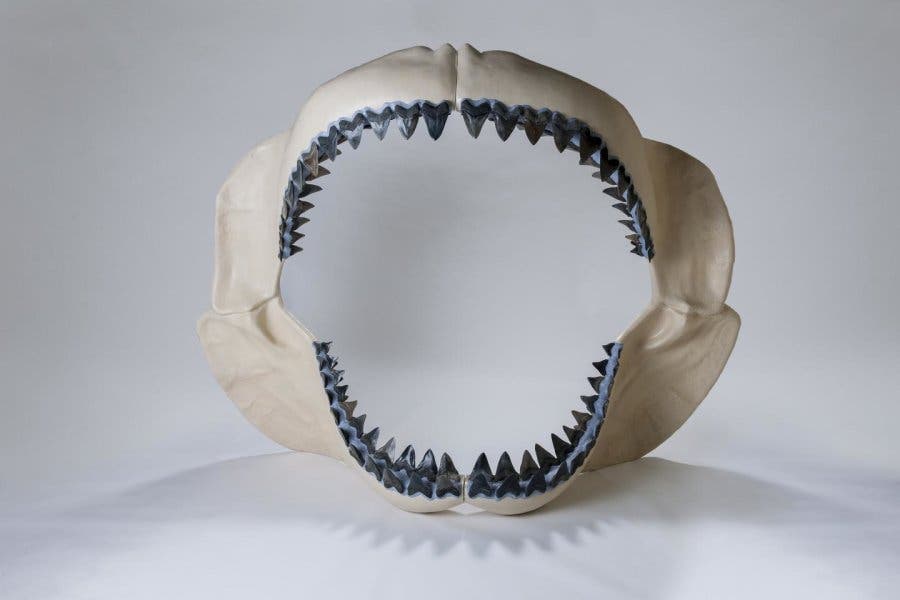These “ultimate cutting tools” were a long time in the making.

Image credits Kristen Grace / Florida Museum of Natural History.
The teeth of megalodon (Carcharocles megalodon), the largest shark ever to prowl the oceans, look like daggers. They’re up to 7 inches (18 cm) long and shaped like blades. But it took them millions of years to evolve into their final shape, new research reveals. The findings created more questions than they answered, as we still don’t know why the process took so long or why it started in the first place.
Big fish, bigger bite
“This transition was a very long, drawn-out process, eventually resulting in the perfect cutting tool — a broad, flat tooth with uniform serrations,” said study lead author Victor Perez, a doctoral student in geology at the Florida Museum of Natural History.
“It’s not yet clear why this process took millions of years and why this feature [serration] was lost.”
Megalodon has to be one of the most awe-inspiring and mysterious animals out there. It was the largest shark ever seen on Earth, but the only trace they’ve left is their teeth. Which is quite fitting for a shark.
But these teeth, according to Perez’s team, evolved over 12 million years. The researchers analyzed the evolutionary path of megalodon teeth and those of its immediate ancestor, Carcharocles chubutensis. Their study revealed a surprisingly slow and gradual process, in which they shifted from large teeth flanked by cusplets to regular, cusplet-less teeth.
The team performed a “census of teeth,” analyzing 359 fossils along with the precise location of their retrieval at the Calvert Cliffs on the western shore of Maryland’s Chesapeake Bay — an area that used to be an ocean in C. chubutensis and megalodon’s day.
Megalodon’s earliest ancestor, Otodus obliquus, boasted three-pronged teeth (i.e. teeth with cusplets) that acted more like forks, the team writes. This suggests that O. obliquus dined on fast-moving (but not too large) fish, and it needed teeth to pin them in place. This species effectively forms the baseline from which later megatooth shark species derived.
The fossil record at Calvert Cliffs spans from about 20 to 7.6 million years ago, so they overlap with both C. chubutensis and megalodon. Perez’s team found a consistent decrease in the number of teeth with lateral cusplets over this timespan. About 87% of teeth from 20 to 17 million years ago had cusplets, falling to about 33% roughly 14.5 million years ago. By 7.6 million years, no fossil teeth had cusplets.
But here’s where the results start getting muddy. While the team notes that adult C. chubutensis had cusplets, and adult megalodon did not, they also caution that this feature is not a reliable identifier of which species a tooth belonged to — juvenile megalodon could have cusplets, making it virtually impossible to discern whether a tooth with cusplets came from C. chubutensis or a young megalodon. Furthermore, some teeth analyzed for the study had tiny bumps or pronounced serrations where cusplets would be. A set of teeth from a single shark even had cusplets on some, no cusplets on others, and replacement teeth with reduced cusplets.
While definitely interesting from a paleontological and biological point of view, such specimens make it virtually impossible for the team to draw clean lines between different species. They can’t pinpoint when megalodon first appeared or when C. chubutensis went extinct.
“As paleontologists, we can’t look at DNA to tell us what is a distinct species. We have to make distinctions based off of physical characteristics,” says Perez. “We feel it’s impossible to make a clean distinction between these two species of sharks. In this study, we just focused on the evolution of this single trait over time.”
So what can the study, then, tell us? Well, it does help to flesh out our understanding of how later megatooth species (such as megalodon) lived, how they hunted, and a bit or two about how they handled disease.
Megalodon fossils have flat teeth, often with serrated edges. Based on their shape, they likely performed a different job than that of its earliest ancestor: that of killing (or at least, mortally wounding) large, fleshy animals like whales or dolphins. Megalodon likely hunted in a single-strike manner: it charged at its prey and chomped down hard. Whatever didn’t die on the spot was left immobilized or too crippled to run away, and bleeding heavily.
“It would just become scavenging after that,” says Perez. “A shark wouldn’t want to grab and hold onto a whale because it’s going to thrash about and possibly injure the shark in the process.”
Lateral cusplets may have been used to grasp prey, according to Perez, which could explain why they disappeared as these sharks shifted to a new hunting style. It’s also possible that the cusplets kept food out from between the sharks’ teeth — so they helped prevent gum diseases. But, frankly speaking, the team simply doesn’t have enough information to know why these structures evolved out of the shark’s teeth.
“It’s still a mystery,” Perez says. “We’re wondering if something was tweaked in the genetic pathway of tooth development.”
One point I found particularly interesting was how important ‘beachcombers’ were for this study. The team says that vast majority of teeth they analyzed were discovered by amateur fossil collectors and donated to museum collections.
“This study is almost entirely built on the contributions of amateur, avocational paleontologists,” Perez notes. “They are a valuable part of research.”
The paper “The transition between Carcharocles chubutensis and Carcharocles megalodon (Otodontidae, Chondrichthyes): lateral cusplet loss through time” has been published in the Journal of Vertebrate Paleontology.


